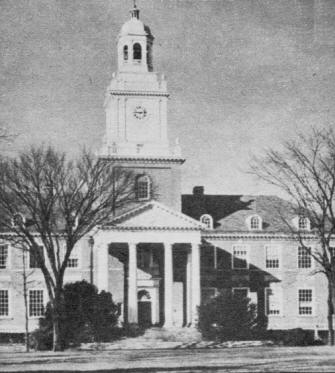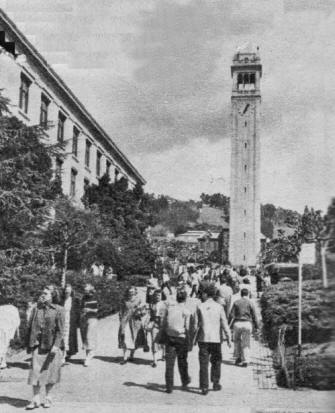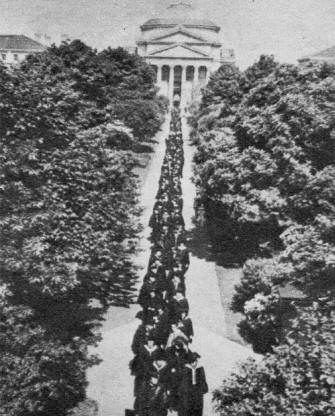|
If you are in college now or contemplating such
a thing, it is probably hard to imagine a time when people fretted over the extravagant costs of obtaining
a degree when a full-time semester at State U. ran as much as $200-300. The entire school scholarship
fund, to be doled out to hundreds of hopeful applicants, totaled a few tens of thousands of dollars
for state schools and half a million for a place like Princeton. A four-year degree might have set you
back $4,000-5,000 including books. Nowadays, of course, freshman courses can run $200-300 per credit
hour and Princeton costs north of $50,000 per year. The cost of a college education has risen
over the years, almost every year, at a rate much greater than inflation. That means it really is costing
more, even in
constant dollar figures, to get a degree - unless you are one of the increasing
number of special status individuals who are getting most or all of their education paid for courtesy
of taxpayers. I paid for every penny of my bachelor's degree in electrical engineering and qualified
for zero dollars of grant money even though both my parents had died years before I started after a
stint in the USAF (joined in 1978 and missed GI Bill by two years), and
paid back every bit of the $8k in student loans I had. Today, my hard-earned taxes pay for a host of
people who are not nearly as hard-up as I was when I went to school - they just happen to be in a more
preferred demographic group than I happen to be a part of.
Borrowed Bucks" for College Years
Special Hobbies Survey for High School Students
There was this guy in high school the fellows called Shaky. Not nervous - just never felt certain
about anything. Wanted to be a doctor, but kept telling people he couldn't see how because it cost a
heap of money and he didn't have a bean. He lived down on River Road with his Grandma Hight, who had
arthritis but took in sewing anyway; Shaky did odd jobs around town after classes. Coach wanted him
to go out for football - said with those shoulders and steady ways he'd make a great guard. But Shaky
said he couldn't take the chance of hurting his hands. Things like that.

Hundreds of non-commercial loans to help students are available. Majority do not
expect repayment till after graduation
Along in his junior year Grandma spoke up: why didn't he apply for one of these scholarships she'd
read about which the lodge his dead pa belonged to gave to children of members? Shaky said those scholarships
were only for a year at a time, didn't cover half the expenses. And as for earning his way - he said
at State they wouldn't pass out part-time jobs to freshmen because of the study load in pre-med. In
his senior year Mrs. Hight broke down and confessed she'd been saving the money he brought in all this
while and along with her egg money there was practically enough for his first go-round.

Massachusetts Institute of Technology has overall loan fund of $1,500,000, with low
interest rate of 1%. Shown above is supersonic wind tunnel that was installed at M.I.T. by Navy.
But Shaky said no'm, even with what he could make during the three summer vacations ahead, plus the
part-time while a soph, he'd barely be able to scrape through till his junior year. And that's when
the going got tough, he said, what with big lab fees and more expensive books.
Know what? At the time Shaky hadn't heard about the loan fund which the State had on tap for its
juniors and seniors which would have knocked the pins from under his final argument. He did hear another
piece of news later ... a state medical body announced it would advance loans of $800 a year for four
years to medical students and cancel the whole thing on agreement of the doc-to-be to practice in rural
sections for a certain period of his career. But by then Shaky had a regular job, $48 a week, and said
he'd been out of school too long.

Florida outstanding in loan programs. Non-profit Florida Loan Corp., for example,
is interested in helping any young resident go to U. of Florida or Florida State U. - from which campus
scene here.
Let us weep no tears for Shaky. Instead, we'll do something constructive by having a look at the
whole picture of loans, another phase of student aid that might be of help to you in getting a college
education. Previously (April 1954) we covered scholarships, meaning outright grants with no repayment
expected. Loans for student aid, of course, spell money that has to be paid back - but these loans are
not the straight commercial kind. For the latter you must put up collaterall to secure the borrowed
amount. And since - let's face it - you don't own any valuable property, and the old homestead is probably
mortgaged enough as it is, we will not here be concerned with the regular commercial loan.

University of Illinois lending fund, well over half million, makes average loan of
$200. Above is seen school's big testing machine exerting force on well casing made of new alloy steel.
Student-aid loans come from two main sources: the colleges themselves and from private organizations
such as foundations, clubs and the like. You put up no collateral. They are betting on your future.
In general these loans are limited to so much a year, from $100 up; $250 per year maximum is typical.
There is also usually a max on the total amount you may borrow during your college career. Interest
rates range 'from 1% to 6%, with 2% to 4% the most prevalent. In the majority of cases the interest
does not start till after graduation, and in practically all instances you do not begin paying back
the note itself until after leaving school.

University of Michigan - The big school at Ann Arbor - U. of Michigan - in an average
year accommodates 2500 students with loans totaling more than $250,000.
Again generally speaking, loans are open chiefly to those in the junior or senior year of their college
career, though some are available to freshmen. They are intended as an adjunct to other forms of aid,
and frequently have the proviso that all such other forms must have been exhausted. You should have
a good scholastic record - though it's not necessary to exhibit genius grades. Obviously, no lazyboners
or chronic moochers need apply. If you are under age, a parent or guardian also signs the promissory
note.

Johns Hopkins University - Johns Hopkins has revolving loan fund of $82,000-plus.
Most institutions of higher learning have loan funds designed to help the worthy, needy student finish
his education. Massachusetts Institute of Technology has conducted such a fund for years; the overall
figure now totals one and a half million dollars; interest is 1%. Carnegie Tech, with a loan fund of
$72,000, charges no interest; average loan is $318. The University of Pennsylvania has $200,000 on tap,
2 1/2% to 3% interest, average loan $300. With these same category heads observed and in the same order,
the following schools may be listed: Oberlin, $311,000, 4%, $200; Princeton, $800,000, 2%, $300; U.
of Calif., $449,000, 5%, $100; St. Louis U., $36,000, 2%, $350; Montana School of Mines, $13,000, 2%,
$100; New York U., $272,000, 4%, $200.
The University of Michigan makes loans to 2500 students totaling more than $250,000 in an average
year. Case Institute of Technology in Cleveland makes loans up to the entire amount of tuition. Ohio
State University has loans of $500-$750 for men. The University of New Hampshire, with a fund of $400,000,
makes loans to sophomores as well as juniors and seniors. And the Dartmouth Educational Association
lets you repay whenever you can after graduation.
A number of fraternal orders and clubs have special money set aside to lend college students. The
Educational Foundation of the Independent Order of Odd Fellows has such loans for children of Odd Fellows
or Rebekahs, with a maximum of $400 for one year and $800 during the whole course. Freshmen are eligible
providing they are planning only a short two-year course, in which case it is not necessary to attend
a regular college. Local units of Lions International make student loans, as do those of Rotary in various
cities. Atlanta (Ga.) Rotary, for instance, will accommodate residents of the state studying there or
elsewhere; and up to one-half of the estimated cost of a year's schooling.

University of California - U. of California conducts large lending program at all
branches - here: Berkeley.
The Worcester (Mass.) Boys Club maintains a fund providing loans up to $1600 during a four-year course
that have no interest involved and may be waived entirely at the discretion of the trustees. You must
reside in Worcester.
And the Educational Aid Fund of the Massachusetts State Grange will lend its junior members money
even as college freshmen embarking on a four-year course, at any school: $250 maximum in anyone year,
and every year if needed.
Most state branches and many local units of Parent-Teachers Associations conduct some student-aid
program that includes college loans. As in the case of fraternal orders, it would be wise to inquire
at your local P.T.A. And labor unions, also at the local as well as state level, are making increasing
provision for loans to members and their children.
If you join a fraternity while at college and find yourself embarrassed financially about continuing
your education, chances are the brothers will help you. Typical is the loan fund of Sigma Chi, which
charges 3% after date of graduation, for members with above-average scholastic rating. Phi Lambda Upsilon,
the national honorary chemical society, also requires a high scholastic record; amounts range from $50
to $300.
The American Society of Mechanical Engineers administers a loan fund for its student members who
are at least in their junior year. The amount depends on individual need. You can be studying mechanical
engineering at any school in the country, and any M.E. undergraduate is invited to join the Society
as a student member.
A growing number of states have programs making money available. to those who wish to enter the medical
profession - and here the figures are big. The Illinois State Medical Society will advance as much as
$5,000 over a period of five years to students native to Illinois counties that need doctors. You repay
within five years after starting practice, at 2%. The Student Loan Fund of the North Carolina Medical
Care Commission provides loans up to $3,200, or a maximum of $800 per year for four years for those
wanting to study medicine or dentistry. Applicants must have been residents of the state for at least
eight years prior to filing, and must promise to practice in small North Carolina towns for at least
four years after graduating. Again, the interest is 2% annually.
And the Kentucky State Medical Association has a fund for loans which are canceled completely on
condition that the student, after getting his diploma, practice in rural areas of the state for as many
years as he was aided by the fund ... Other states have liberal loan arrangements for prospective doctors.
Inquire at your state department of education.
All over the land private citizens of wealth desiring to make the road less rocky for students in
need have set up foundations to lend them money while in college. And the process goes on continually.
Generally the founder exercises his privilege of laying down certain restrictions as to who may apply
or the kinds of courses for which the money is available.
Unusual is the character of the Slemp Foundation - not for being confined to residents or descendants
of residents of Virginia's Wise County, but because the loan may be "forgiven" if the recipient attains
high scholastic or special honors, in his college career. The greater the honors, the less to be repaid.
Mr. Slemp's initial plan, for instance, called for a 50% reduction of the note for a semester in which
the borrower made at least four straight A's, with at least passing grades in all other subjects.

Franklin and Marshall College
The Henry Strong Educational Foundation Loan Fund is open to students attending Western and Southern
colleges (juniors and seniors). Application preference is given those taking practical, scientific or
business courses. Repayments may be made over a period of four years after graduation, at 3%. On the
other hand, no interest is charged by the Hattie M. Strong Foundation, Inc., nor is there a set period
for paying back. No qualifications are stipulated as to race, color or creed. Loans may be had up to
$450 per year, with a course maximum of $1,000.
The Davis Cooperative Educational Plan, operating in Iowa, has for its purpose aiding the average
and persistent student rather than the super-bright. Among the questions asked on the application blank
are: how have you proved your initiative in earning, saving or using money? What is your hobby? How
do you spend your spare time? There is no set amount. Recipients must promise not to join fraternities
or enter into marriage before the loan is repaid. Mr. Edwin W. Davis keeps a paternal eye on his "alumni"
for years after graduation, recording their progress.
Some religious groups have student lending programs. Loans for Jewish young men and women are made
by the B'nai B'rith Hillel Foundations at American Universities. No interest charges, and no legal obligation
to repay - though recipients are expected to return the money when able. Those living in Chicago, Los
Angeles and New York are given preference.
The Presbyterian Church - which has yet other loan funds open at its church colleges - conducts one
plan whereby those preparing for church work may repay borrowed money by donating one year of service
to the Presbyterian Church U.S.A.

N.Y.U., which operates five centers throughout New York City in addition to one at
University Heights where commencement photo was taken, has more than $1,250,000 on tap to lend needy
students.
Industry also is represented. Many large corporations provide loans to employees or children of employees
who require money to finish their studies. Burlington Mills runs a foundation whose funds are available
in any community where the company operates. You can get up to $500 for the first year and renewals
up to five years. Nor must you work in the textile field after graduation. General Electric conducts
two kinds of loan plans for children of employees, In the first ($250 per year maximum) the student
repays after finishing school. The second plan ($200 per year at the most) allows the parents to repay
by payroll deduction, from the start of the loan.
Although having no connection with that firm, the John and Olga Queeny Educational Foundation makes
loans without interest and not over $500 to children of employees of Monsanto Chemical Co. or one of
its subsidiaries, who have been at least five years in service.
An often unsuspected source of student loans is banks - and we don't mean the standard commercial
kind of loan. Banks may be named to administer funds to lend needy scholars, as in the case of the First
National of Portland, Ore., which handles the Crawford Student Loan Fund for Men (maximum $1,000). This
one, mainly for residents of that city or residents going to school elsewhere, favors those studying
mechanical arts, business and the like - but not law, medicine, teaching or theology.

At Ohio State, qualified men students may borrow $500 to $750.
Although not in the student loan field as considered here, a method for paying college expenses on
the installment plan is offered through the Tuition Plan. This permits the payment of tuition and other
academic fees in monthly installments, while the school or college receives the full amount at the beginning
of the term. The additional cost of this service is 4%. intended primarily as a convenience, the Plan
is of special help in cases where parents have "budget trouble" during the fall and winter months when
expenses are greatest.
The Tuition Plan is available at about 400 authorized institutions throughout the country. If the
contract - always made with the school - is for the conventional academic year, payments are in eight
equal monthly installments. If it is for. any other period, the payments are made in as many equal installments
as there are months in the period. To learn whether or not the school of your choice is on the authorized
list, write to The Tuition Plan, Inc., 347 Fifth Ave., New York 16, N. Y.
Stevens Institute of Technology at Hoboken, N. J., has a time-payment arrangement of its own. Called
the "Pay-As-You-Go" Plan, it enables students to pay for a full year's cost of tuition, books, laboratory
fees, dormitory charges and other school expenses in 12 monthly installments, rather than in lump sums
at the beginning of each semester. Two metropolitan banks advance the money to the Institute, and you
pay the banks. (If you're under 21, parents or guardian must sign the notes.) Interest charges are 4%.
The amount of the loan varies according to individual need.
Say the loan is for $100: then the student or parent signs a note for $104, and repays in 12 monthly
installments of $8.67 each.
Another set-up at Stevens for easing the financial burden, although not in the loan category, might
be mentioned here for its uniqueness. This is the Tuition and Scholarship Plan, whereby parents may
make modest monthly payments toward their son's engineering course prior to his enrollment.
This has several advantages. The first is that of permitting parents to spread the cost of a four-year
course over a minimum of five and a half years, instead of making a few large payments when college
bills come due. Second, the plan contains provision for the student to complete his education without
charge in case the parent dies before he graduates. Third, the parent is not required to pay additional
expenses, up to a certain limit, if the school raises its tuition fee while the contract is in force.
Still another advantage is that those accepted for the Stevens T&S Plan gain automatic priority
in the event the college must limit the number of freshmen it can accommodate.
If you find it necessary to borrow bucks for college by all means investigate right in your own town,
region or state. The Feild Cooperative Association of Mississippi has 300 loans a year, for Mississippians
only. In Baltimore, the Central Scholarship Bureau will lend up to $700 to student residents - but the
money must be used directly for your educational needs (tuition, lab fees, etc.) and not for room and
board. The Parish Loan Fund of Louisiana, established by the state legislature, permits high school
grads to borrow up to $400 for anyone year for their college education. The Florida Loan Corporation
is interested in helping any needy boy or girl in the state obtain a higher education at the University
of Florida or Florida State U. While a Rotarian enterprise, it is not necessary for the recipient to
come from a town having a Rotary Club.
Warning: Don't be a Shaky. If you hanker to go to college, don't give up the idea because of lack
of money. Start planning now. Learn what scholarships are available to you. Remember that at some of
the largest colleges half the students earn all or part of their way. And as this survey on loans was
intended to show, there are lots of folks in this country who stand ready to help young fellows with
their education in case the financial picture grows dim no matter how hard you crank the generator.
Measure up, mister! Your future is worth the effort.
Posted April 4, 2015
|


